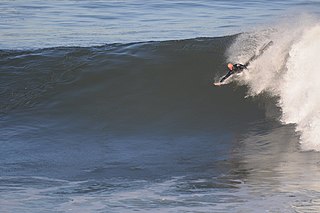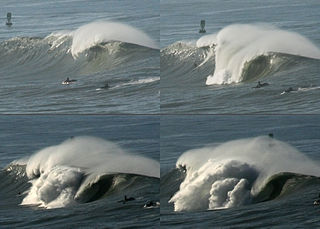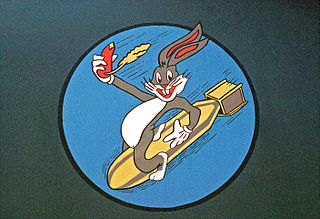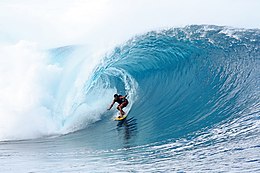
Surfing is a surface water sport in which an individual, a surfer, uses a board to ride on the forward section, or face, of a moving wave of water, which usually carries the surfer towards the shore. Waves suitable for surfing are primarily found on ocean shores, but can also be found in standing waves in the open ocean, in lakes, in rivers in the form of a tidal bore, or in wave pools.

Bodysurfing is the art and sport of riding a wave without the assistance of any buoyant device such as a surfboard or bodyboard. Bodysurfers often equip themselves with a pair of swimfins that aid propulsion and help the bodysurfer catch, ride, and kick out of waves. Some bodysurfers also use a wooden or foam handplane, which helps to get one's chest out of the water to reduce drag, this is known as handplaning and is an offshoot of bodysurfing.

Skimboarding or skimming is a boardsport in which a skimboard is used to glide across the water's surface to meet an incoming breaking wave, and ride it back to shore. There are currently 3 U.S. based competitive organizations including Premier Skim, Skim USA, and the United Skim Tour. Wave-riding skimboarders perform a variety of surface and air maneuvers, at various stages of their ride, out to, and back with, the wave. Some of these are known as "wraps", "big spins", "360 shove-its" and "180s". Unlike surfing, skimboarding begins on the beach by dropping the board onto the thin wash of previous waves. Skimboarders use their momentum to skim out to breaking waves, which they then catch back into shore in a manner similar to surfing.

Train surfing is typically a reckless, dangerous and illegal act of riding on the outside of a moving train, tram or other forms of rail transport. In a number of countries, the term 'train hopping' is used synonymously with freight hopping, which means riding on the outside of a freight train, while train surfing can be practiced on any type of train. This type of travelling can be extremely dangerous and even life-threatening, because there is a risk of death or serious injury due to falling off a moving train, electrocution by the power supply, colliding with railway infrastructure such as bridges, tunnels, station platforms, trackside buildings, railway signals or other trains, while riding outside off structure gauge on the side or on the roof of a train, or unsuccessful attempts to jump onto a moving train or off it. Today, the practice is illegal by statutes on many railroads in the world. Despite this, it is still practiced, especially on those railroads where the trains are overcrowded.

Mavericks is a surfing location in northern California outside Pillar Point Harbor, just north of the town of Half Moon Bay at the village of Princeton-by-the-Sea. After a strong winter storm in the northern Pacific Ocean, waves can routinely crest at over 25 ft (8 m) and top out at over 60 ft (18 m). Routinely, waves that break can be recorded on seismometers. The break is caused by an unusually shaped underwater rock formation.

Big wave surfing is a discipline within surfing in which experienced surfers paddle into, or are towed into, waves which are at least 20 feet high, on surf boards known as "guns" or towboards. Sizes of the board needed to successfully surf these waves vary by the size of the wave as well as the technique the surfer uses to reach the wave. A larger, longer board allows a rider to paddle fast enough to catch the wave and has the advantage of being more stable, but it also limits maneuverability and surfing speed.

George Hamilton Perkins Greenough is an influential surfer, known during the 1960s and 1970s for his work in film, and in surfboard design, fin characteristics, and other creations for the aquatic medium. The contributions of Greenough, along with Bob McTavish, to the development of short boards resulted in a number advances in surfboard shaping and other surfing technology.

The Banzai Pipeline, or simply Pipeline or Pipe, is a surf reef break located in Hawaii, off Ehukai Beach Park in Pupukea on O'ahu's North Shore. A reef break is an area in the ocean where waves start to break once they reach the shallows of a reef. Pipeline is known for huge waves that break in shallow water just above a sharp and cavernous reef, forming large, hollow, thick curls of water that surfers can tube ride. There are three reefs at Pipeline in progressively deeper water farther out to sea that activate according to the increasing size of approaching ocean swells.

Noseriding is the art of maneuvering a surfboard from the front end.

Shaun Tomson is a South African professional surfer and former world champion, environmentalist, actor, author, and businessman. He has been listed among the top 10 surfers of the century, and was the 1977 World Surfing Champion.
Artificial waves are human-made waves usually created on a specially designed surface or in a pool.

Malik Joyeux was an accomplished all-around waterman and a professional Big Wave surfer. Known by many as the "petit prince", the goofy-foot surfer often gained attention for charging the treacherous barrels at Teahupoo, Tahiti. He was credited in 2003 with the Billabong XXL Tube of the Year for riding one of the largest waves ever to be surfed in history.
G-Land, also known as Plengkung Beach, is an internationally renowned surf break on Grajagan Bay, Banyuwangi, Alas Purwo National Park, East Java, Indonesia, about half a day by road from the popular tourist destinations of Bali. It is most commonly reached via boat charter from Bali.

Peʻahi is a place on the north shore of the island of Maui in the U.S. state of Hawaii. It has lent its name to a big wave surfing break, also known as Jaws.

The riding of waves has likely existed since humans began swimming in the ocean. In this sense, bodysurfing is the oldest type of wave-catching. Undoubtedly ancient sailors learned how to ride wave energy on many styles of early boats. Archaeological evidence even suggests that ancient cultures of Peru surfed on reed watercraft for fishing and recreation up to five thousand years ago. However, standing up on what is now called a surfboard is a relatively recent innovation developed by the Polynesians. The influences for modern surfing can be directly traced to the surfers of pre-contact Hawaii.

Flowriding is a late 20th century alternative boardsport incorporating elements of surfing, bodyboarding, skateboarding, skimboarding, snowboarding and wakeboarding.

A surf break is a permanent obstruction such as a coral reef, rock, shoal, or headland that causes a wave to break, forming a barreling wave or other wave that can be surfed, before it eventually collapses. The topography of the seabed determines the shape of the wave and type of break. Since shoals can change size and location, affecting the break, it takes commitment and skill to find good breaks. Some surf breaks are quite dangerous, since the surfer can collide with a reef or rocks below the water.

This glossary of surfing includes some of the extensive vocabulary used to describe various aspects of the sport of surfing as described in literature on the subject.[a][b] In some cases terms have spread to a wider cultural use. These terms were originally coined by people who were directly involved in the sport of surfing.

Teahupoʻo is a village on the southwestern coast of the island of Tahiti, French Polynesia, in the southern Pacific Ocean.

Garrett "GMAC" McNamara is an American professional big wave surfer best known for setting the world record for largest wave ever surfed, as documented in the HBO series 100 Foot Wave. McNamara is also known for successfully negotiating a monstrous barrel at Jaws and being the first person ever to ride a wave formed from calving glaciers.



















